Mastering ArchiMate: A Comprehensive Guide to Enterprise Architecture Modeling
Introduction to Enterprise Architecture and ArchiMate
What is Enterprise Architecture?
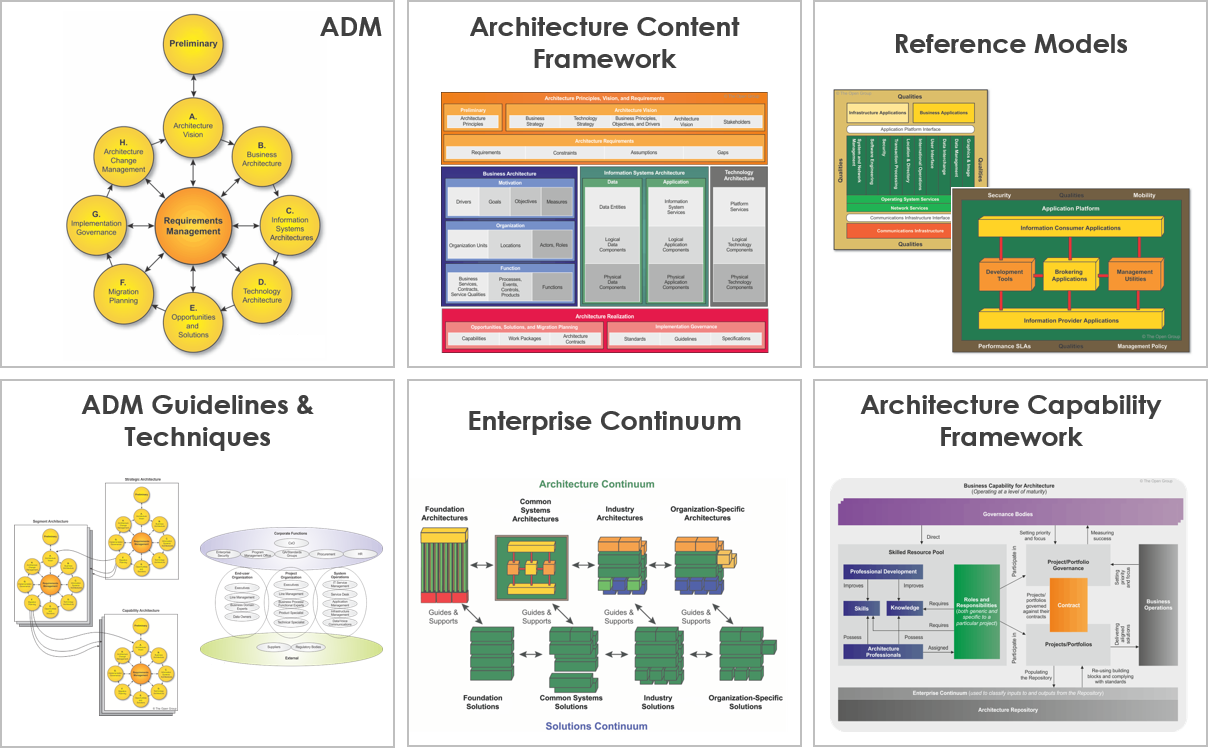
Enterprise Architecture (EA) is a holistic approach to managing the complexity and interdependence of an organization’s business processes, information technology (IT) systems, and infrastructure. EA provides a blueprint of the enterprise that describes how different parts of the organization work together to achieve its strategic goals.
At a high level, enterprise architecture encompasses the following aspects:
- Business architecture: Describes the organization’s business processes, capabilities, goals, and strategies.
- Information architecture: Defines the organization’s information strategy, including the data and information needed to support the business processes.
- Application architecture: Describes the organization’s application systems and how they support the business processes.
- Technology architecture: Defines the organization’s technology infrastructure, including hardware, software, and network components.
EA helps organizations align their business and technology strategies, improve operational efficiency, and reduce IT costs. By providing a standardized view of the organization’s operations and resources, EA enables better decision-making, risk management, and change management. It also facilitates communication between different stakeholders, such as business managers, IT professionals, and external partners.
EA frameworks, such as TOGAF (The Open Group Architecture Framework) and Zachman Framework, provide a structured approach to developing and implementing enterprise architecture. These frameworks define the key principles, concepts, and artifacts that should be included in an enterprise architecture program.
Why is Enterprise Architecture important?

Enterprise Architecture (EA) is important for several reasons, including:
- Aligning business and technology strategies: EA provides a way to align an organization’s business goals and objectives with its technology investments. This alignment helps to ensure that technology solutions are designed and implemented in a way that supports the organization’s overall strategy.
- Enabling innovation: EA helps to identify opportunities for innovation and enables organizations to take advantage of emerging technologies. By providing a structured approach to technology planning and decision-making, EA can help organizations to stay ahead of the curve and adapt to changing market conditions.
- Improving operational efficiency: EA helps to identify redundancies and inefficiencies in an organization’s business processes and technology systems. By streamlining these processes and systems, EA can help to reduce costs and improve operational efficiency.
- Managing complexity: As organizations grow and evolve, they become more complex. EA provides a way to manage this complexity by providing a holistic view of the organization and its components. This view can help to identify dependencies and relationships between different parts of the organization, enabling better decision-making and risk management.
- Enhancing agility: In today’s fast-paced business environment, organizations need to be agile and responsive to changing market conditions. EA can help organizations to be more agile by providing a way to quickly assess the impact of changes to business processes and technology systems.
Overall, EA is important because it helps organizations to better understand their operations and resources, make better decisions, and adapt to changing market conditions. It provides a way to align business and technology strategies, improve operational efficiency, and manage complexity.
What is ArchiMate?
ArchiMate® is a powerful and widely-used graphical language that provides a standardized way to describe enterprise architectures. It was developed and is maintained by The Open Group®, an independent organization dedicated to promoting the development of open, vendor-neutral technology standards and certifications.
ArchiMate® is designed to provide a visual representation of the different components and relationships within an enterprise architecture. It uses a set of symbols and notations to represent various elements of an architecture, such as business processes, information flows, organizational structures, and technology infrastructure. By using these symbols and notations, architects can create diagrams and models that effectively communicate complex architectures to a wide range of stakeholders.
One of the key benefits of ArchiMate® is its flexibility. The language can be used to create a wide range of viewpoints, each of which is relevant to different project and business stakeholders. For example, a business architect might use ArchiMate® to create a high-level view of the business processes and organizational structures, while a data architect might use it to create a more detailed view of the data flows and information systems. Similarly, solution architects might use ArchiMate® to create detailed diagrams of specific technology solutions, while infrastructure architects might use it to model the underlying hardware and network infrastructure.
Overall, ArchiMate® is a valuable tool for enterprise architects who need to communicate complex architectures to a wide range of stakeholders. By using a standardized language and notation, architects can ensure that their diagrams and models are clear, concise, and easily understood by all stakeholders. Additionally, ArchiMate® is an open standard, which means that it is not tied to any particular vendor or technology, making it a flexible and adaptable tool for architects in any organization.
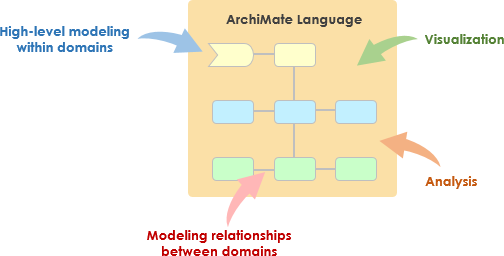
The ArchiMate Core Framework
The ArchiMate Core Framework consists of three layers that represent the different levels at which an enterprise can be described. These layers are the Business Layer, the Application Layer, and the Technology Layer.
- The Business Layer represents the business services offered to customers and the business processes that support these activities. These activities are carried out by business roles within the organizational structure. The Business Layer is concerned with the high-level view of the enterprise’s operations and the services it offers to its customers.
- The Application Layer represents the software applications that support business processes. It also represents the application services they offer and the interfaces between them that permit the exchange of information. The Application Layer is concerned with the implementation of the business processes in terms of the applications and services that support them.
- The Technology Layer represents the communication hardware and system software needed to provide technology services to support and run the applications. The Technology Layer is concerned with the infrastructure that supports the applications and services.
ArchiMate Aspects are used to model the different elements that exist within each layer. There are three Aspects: Active Structure, Behavior, and Passive Structure.
- The Active Structure Aspect depicts the structural elements or “subjects of an activity” such as business actors, application components, and devices that display actual behavior. This aspect is concerned with the actors that carry out the business processes and the components that support them.
- The Behavior Aspect represents the processes, functions, events, and services that are performed by the structural elements. This aspect is concerned with the actions and interactions that take place within the enterprise.
- The Passive Structure Aspect depicts objects such as information and data objects on which behavior is performed. It can also include physical objects. This aspect is concerned with the objects that are acted upon by the processes and the components that support them.
By using these layers and aspects, architects can create a complete and detailed view of the enterprise’s architecture. This helps to ensure that the architecture is clear, concise, and easily understood by all stakeholders. Additionally, by using a standardized set of layers and aspects, architects can ensure that their diagrams and models are consistent and conform to best practices in enterprise architecture.
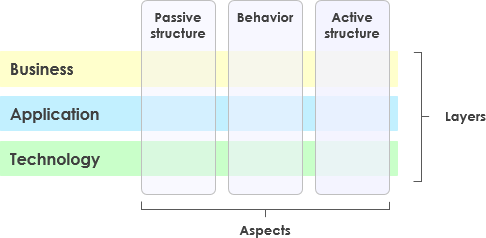
The full ArchiMate framework
The ArchiMate framework has evolved over time and the latest version (version 3.1) includes additional layers and an aspect to provide a more comprehensive view of enterprise architecture. The full ArchiMate framework includes the original three layers of the Core Framework (Business, Application, and Technology) and adds three new layers: Strategy, Physical, and Implementation and Migration.
- The Strategy layer is used to model an organization’s capabilities and how they need to change to meet desired business outcomes. It includes elements such as Goals, Drivers, Principles, and Requirements.
- The Physical layer has been added as an extension to the Technology layer and is used for modeling physical things such as equipment, facilities, distribution networks, and materials. This layer allows for a more detailed representation of the technical infrastructure of the enterprise.
- The Implementation and Migration layer is used to model the implementation and migration of architectures. This includes program, portfolio, and project management, as well as a plateau element supporting migration planning. The Implementation and Migration layer enables architects to model the different stages of implementing a new architecture and the associated risks and dependencies.
In addition to the layers, the full ArchiMate framework also includes the Motivation aspect. The Motivation aspect is used to model the motivation behind business change that guides the design and evolution of architectures. It includes elements such as Stakeholders, Drivers, Goals, and Outcomes. The Motivation aspect enables architects to model the underlying reasons for changes in the enterprise and to align architecture decisions with business goals and objectives.
By incorporating these additional layers and aspect, the full ArchiMate framework provides a more complete and detailed view of enterprise architecture. This allows architects to create more comprehensive and accurate models that support decision-making and help ensure that the enterprise’s architecture aligns with its strategic goals and objectives.
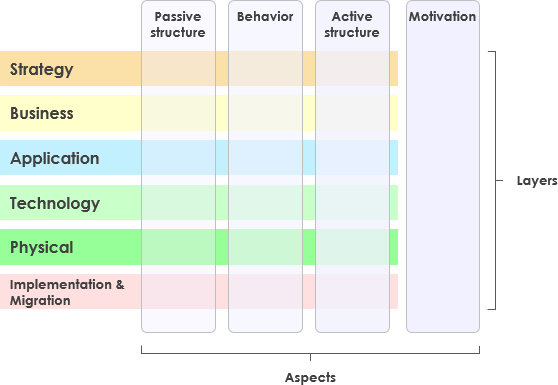
The Use of Colors in ArchiMate Framework
In ArchiMate, colors are used to differentiate between the different layers and aspects of the framework. The use of colors is not mandatory, but it is a widely accepted practice to help distinguish between different types of elements in a model.
The three layers of the framework are represented by the colors yellow, blue, and green. The Business layer elements are represented in yellow, the Application layer elements are in blue, and the Technology layer elements are in green. These colors help to differentiate between the types of elements and provide a quick visual cue for the viewer.
Similarly, the four aspects of the framework are represented by different shades of grey. The Abstract concepts are represented in white, Passive structures in light grey, Behaviors in medium grey, and Active structures in dark grey. This helps to differentiate between the different types of elements within each layer and provides additional information about their role in the architecture.
While the use of color is not mandatory, it can be a useful tool for architects to help communicate their designs to others. By using consistent colors throughout a model, architects can make it easier for stakeholders to understand and interpret the architecture. However, it is important to note that the semantics of the colors are not formal or compulsory, and the use of color in ArchiMate models is entirely at the modeler’s discretion.
How are Model Elements Organized in ArchiMate?
ArchiMate® provides a structured way to analyze service-oriented models through its three layers: business, application, and technology. As we move down the layers, we gain more insights into implementation details (sometimes referred to as “realization”).
The business layer, at the top level, focuses on the services provided to customers. The application layer, in the middle, focuses on the applications that support those services, which are available to customers. At the bottom, we find the technology layer that depicts the technical infrastructure offering services to those applications in the application layer.
To illustrate this, consider the following ArchiMate 3 diagram, which shows both the technology and application layers. Here, we can see that the Inpatient Care Management application is realized through the infrastructure, messaging service, and data access service.
Example: Application Co-Operation
The ArchiSurance Case Study involves two separate departments, the front office and back office of an insurance company, which need to collaborate to enhance customer service:
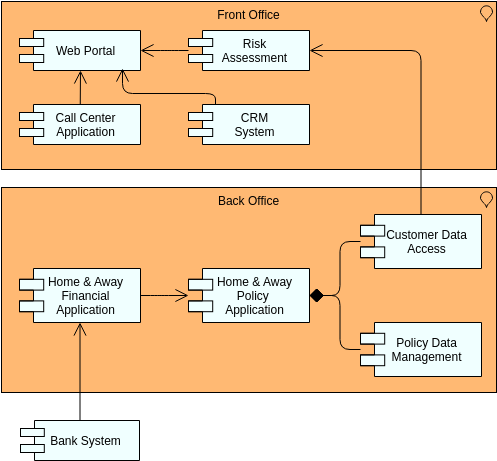
For example, After analyzing the current situation, the focus shifts towards modeling the target enterprise architecture, i.e., the actions required to improve the current scenario.
Relationship between ArchiMate and TOGAF
The TOGAF Framework and the ArchiMate language are both developed and maintained by The Open Group. The TOGAF Framework is a comprehensive framework for enterprise architecture that provides a common language, methodology, and tools for designing and managing enterprise architecture. On the other hand, ArchiMate is a graphical language used to describe enterprise architecture, including business processes, organizational structures, information flows, IT systems, and technical infrastructure.
While the TOGAF Framework provides a methodology for developing and managing enterprise architecture, ArchiMate provides a modeling language to represent and communicate architecture concepts and solutions. ArchiMate can be used to create different viewpoints, each relevant to different project and business stakeholders, and these viewpoints can be aligned with the ADM phases of the TOGAF Framework.
The core language of ArchiMate closely corresponds to TOGAF’s ADM, which provides a step-by-step approach to developing enterprise architecture. The ADM phases include developing an architecture vision, developing an architecture framework, conducting a baseline architecture description, conducting a target architecture description, conducting a gap analysis, defining the roadmap for implementation, and implementing the architecture.
ArchiMate complements the ADM by providing a graphical representation of the architecture concepts and solutions, which can be used to communicate the architecture to stakeholders. By combining the TOGAF Framework with ArchiMate, organizations can develop a comprehensive approach to enterprise architecture that includes both a methodology and a modeling language. This can help organizations to better understand and manage their enterprise architecture, and to communicate it effectively to stakeholders.
Mapping of ArchiMate Layers to TOGAF ADM Phases
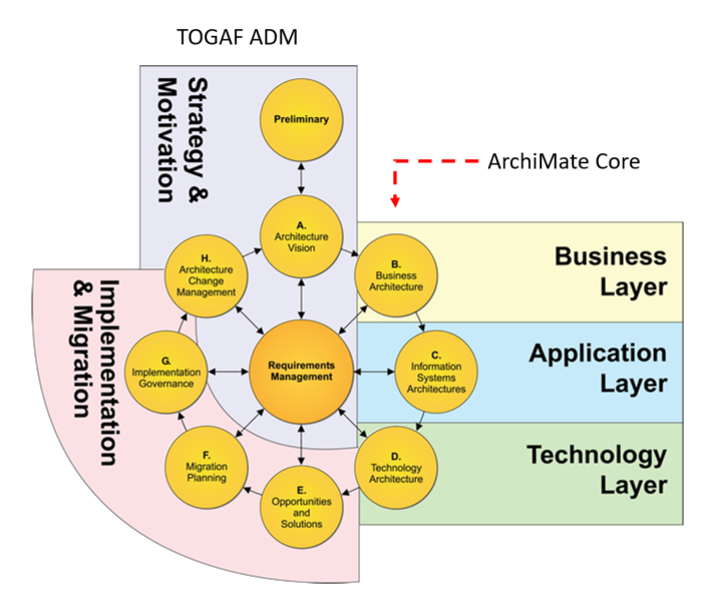
The ArchiMate layers can be mapped to the TOGAF ADM phases as follows:
- Business Layer: The Business Layer of ArchiMate maps to the Preliminary Phase and the Phase A – Architecture Vision of the TOGAF ADM. In this phase, the enterprise architecture team identifies business goals, objectives, and drivers that impact the enterprise architecture.
- Application Layer: The Application Layer of ArchiMate maps to the Phase B – Business Architecture and Phase C – Information Systems Architecture of the TOGAF ADM. In this phase, the enterprise architecture team defines the business processes, information flows, and application components needed to support the business goals identified in the previous phase.
- Technology Layer: The Technology Layer of ArchiMate maps to the Phase D – Technology Architecture and Phase E – Opportunities and Solutions of the TOGAF ADM. In this phase, the enterprise architecture team defines the technology infrastructure needed to support the application components identified in the previous phase.
- Physical Layer: The Physical Layer of ArchiMate maps to the Phase F – Migration Planning and Phase G – Implementation Governance of the TOGAF ADM. In this phase, the enterprise architecture team develops a detailed implementation plan to move from the current architecture to the target architecture, and governance mechanisms to ensure that the implementation stays on track.
- Motivation Aspect: The Motivation Aspect of ArchiMate maps to the Preliminary Phase and the Phase A – Architecture Vision of the TOGAF ADM, as well as the Phase H – Architecture Change Management and Phase I – Requirements Management. In this phase, the enterprise architecture team identifies the stakeholders, their concerns, and requirements for the architecture, and develops a plan to manage changes to the architecture over time.
Mapping the ArchiMate layers to the TOGAF ADM phases provides a structured approach to developing an enterprise architecture that aligns with the business goals and objectives. It also helps to ensure that the architecture is implemented in a structured and organized way, with governance mechanisms in place to manage changes over time.
Create professional and detailed ArchiMate diagrams online using Visual Paradigm Online.
With ArchiMate’s rich set of modeling notations and concepts, you can easily visualize different aspects of your enterprise architecture, consistently within and across domains. Visual Paradigm Online offers a free ArchiMate diagram tool that supports the notation and syntax of the ArchiMate 3 visual modeling language, allowing you to create high-quality diagrams with ease. Whether you’re modeling business processes, application architectures, or technology infrastructure, Visual Paradigm Online has got you covered. If you need more inspiration, Visual Paradigm Online offers a wide range of ArchiMate templates and examples in its online drawing tools.

